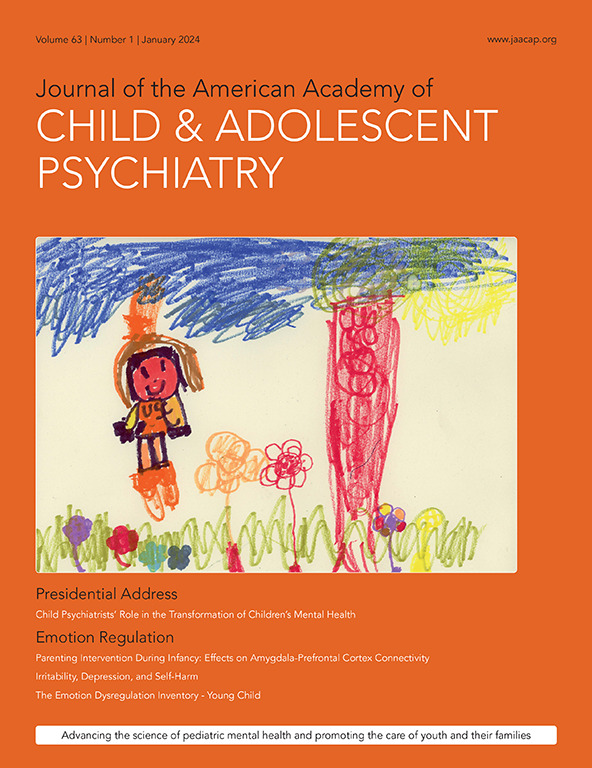Investigating the Shared and Divergent Neuroanatomical Features of Attentional Deficits in Adolescents.
IF 9.2
1区 医学
Q1 PEDIATRICS
Journal of the American Academy of Child and Adolescent Psychiatry
Pub Date : 2025-05-16
DOI:10.1016/j.jaac.2025.05.006
引用次数: 0
Abstract
OBJECTIVE Cognitive disengagement syndrome (CDS), formerly known as sluggish cognitive tempo, is characterized by hypo-activity or slowed behavior, mental fogginess or confusion, excessive sleepiness, and daydreaming. CDS and the predominantly inattentive (IN) presentation of attention-deficit/hyperactivity disorder (ADHD) are frequently co-occurring though separable constructs, each associated with unique constellations of functional impairments. The current study aims to identify their shared and divergent neurobiological correlates. METHOD One hundred eighty-one adolescents (Mage=13.9, SDage=2.2) were recruited from the Colorado Learning Disabilities Research Center twin study. Relationships between attentional symptom dimensions - CDS and IN - and brain volume were examined, controlling for age, sex, and average cortical volume. Procedures were repeated in an outside sample of 292 adolescents (Mage=16.8, SDage=1.4) using a 2-item measure of CDS. RESULTS Higher levels of CDS symptoms were associated with reduced volume within left ventral parietal, temporo-parietal and temporal regions, regions which fall within the ventral attention network. CDS and IN symptoms were significantly associated with gray matter volume in portions of the dorsal attention and default mode networks in opposite directions. Higher levels of CDS symptoms were associated with reduced volume in the left superior and inferior parietal lobules and left frontal portions of the default mode network, whereas IN symptoms were positively correlated with volume in these areas. Several findings were consistent in the outside sample. CONCLUSION Results from the current study provide novel insights into the neurobiological basis of CDS. They suggest that both CDS and IN symptoms are associated with alterations in brain systems that exert top-down attentional control, though likely for differing reasons. The current study enhances understanding of adolescent attentional deficits.研究青少年注意缺陷的共同和不同的神经解剖学特征。
目的认知脱离综合征(cognitive disengagement syndrome, CDS),以前被称为认知节奏迟缓,其特征是活动减少或行为迟缓,精神模糊或混乱,过度嗜睡和做白日梦。CDS和主要的注意力不集中(IN)表现为注意缺陷/多动障碍(ADHD)经常通过可分离的结构同时发生,每个结构都与独特的功能障碍星座相关。目前的研究旨在确定它们的共同和不同的神经生物学相关性。方法从科罗拉多学习障碍研究中心的双胞胎研究中招募了81名青少年(Mage=13.9, SDage=2.2)。在控制年龄、性别和平均皮质体积的情况下,检查了注意症状维度(CDS和IN)与脑容量之间的关系。在292名青少年(Mage=16.8, SDage=1.4)的外部样本中,使用两项CDS测量方法重复上述步骤。结果较高水平的CDS症状与左侧腹侧顶叶、颞顶叶和颞叶区域的体积减少有关,这些区域属于腹侧注意网络。CDS和IN症状与相反方向部分背侧注意和默认模式网络的灰质体积显著相关。高水平的CDS症状与左侧顶叶上、下小叶和左额叶默认模式网络的体积减少有关,而in症状与这些区域的体积正相关。在外部样本中有几个发现是一致的。结论本研究结果为CDS的神经生物学基础提供了新的见解。他们认为,CDS和IN症状都与自上而下的注意力控制的大脑系统的改变有关,尽管可能有不同的原因。目前的研究增强了对青少年注意力缺陷的理解。
本文章由计算机程序翻译,如有差异,请以英文原文为准。
求助全文
约1分钟内获得全文
求助全文
来源期刊
CiteScore
21.00
自引率
1.50%
发文量
1383
审稿时长
53 days
期刊介绍:
The Journal of the American Academy of Child & Adolescent Psychiatry (JAACAP) is dedicated to advancing the field of child and adolescent psychiatry through the publication of original research and papers of theoretical, scientific, and clinical significance. Our primary focus is on the mental health of children, adolescents, and families.
We welcome unpublished manuscripts that explore various perspectives, ranging from genetic, epidemiological, neurobiological, and psychopathological research, to cognitive, behavioral, psychodynamic, and other psychotherapeutic investigations. We also encourage submissions that delve into parent-child, interpersonal, and family research, as well as clinical and empirical studies conducted in inpatient, outpatient, consultation-liaison, and school-based settings.
In addition to publishing research, we aim to promote the well-being of children and families by featuring scholarly papers on topics such as health policy, legislation, advocacy, culture, society, and service provision in relation to mental health.
At JAACAP, we strive to foster collaboration and dialogue among researchers, clinicians, and policy-makers in order to enhance our understanding and approach to child and adolescent mental health.

 求助内容:
求助内容: 应助结果提醒方式:
应助结果提醒方式:


